A real-deal dan dan noodle recipe that stays true to the authentic Sichuan flavor. This post covers all the key ingredients and includes a super rich and balanced sauce to recreate the classic dish that tastes like China.
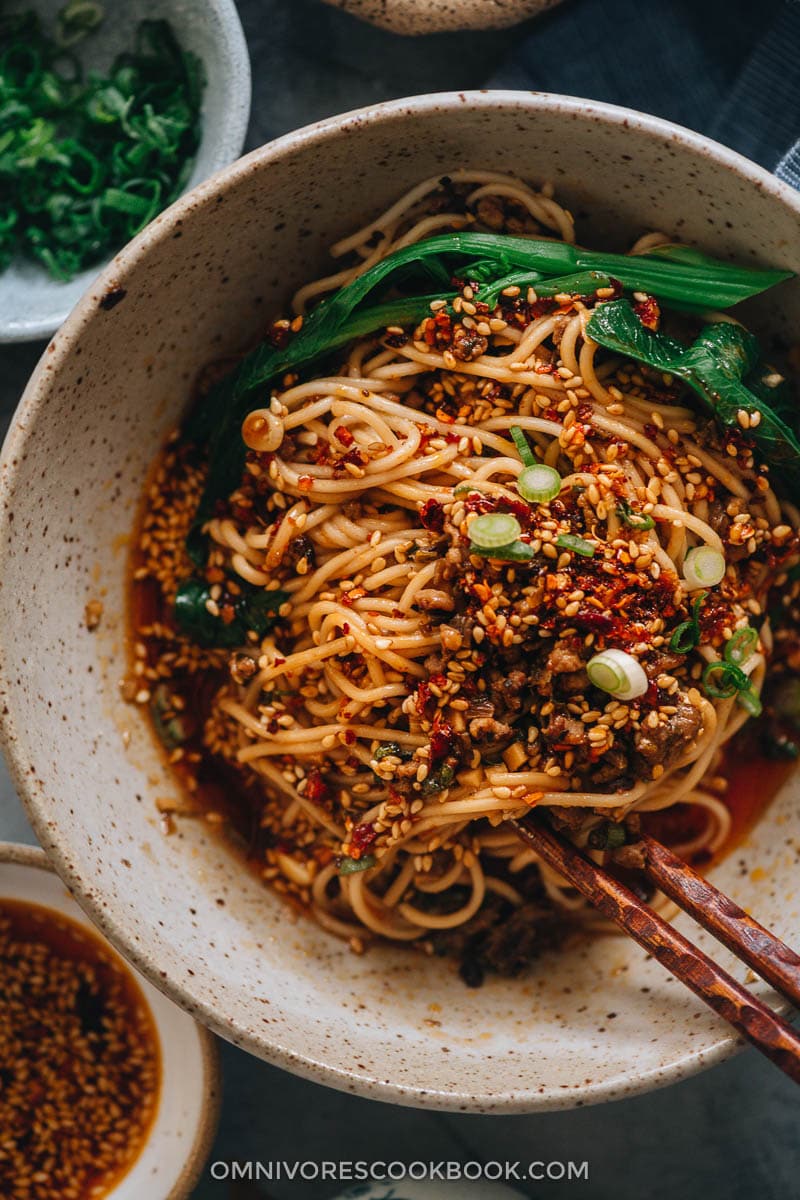
Dan dan Noodles is such a classic dish that is really worth the effort to master. I’ve been improving the recipe since I first published it back in 2014, and this is the third version.
You can head straight to the recipe if you already know the dish. If you are new to Chinese cooking, I recommend browsing the post first so you can learn about the ingredients and pick up a few helpful cooking tips that support the Authentic Chinese noodle recipes collection.
What are Dan Dan Noodles?
Dan Dan Noodles (担担面, dan dan mian) are one of the most famous of Sichuan street foods. The freshly boiled thin noodles are served in a savory, spicy sauce topped with crispy pork and peanut flakes. Simply stir everything together with a pair of chopsticks to coat the noodles with a bit of everything and slurp! The numbing, smoky, spicy sauce will shock your taste buds, leaving you craving for more.
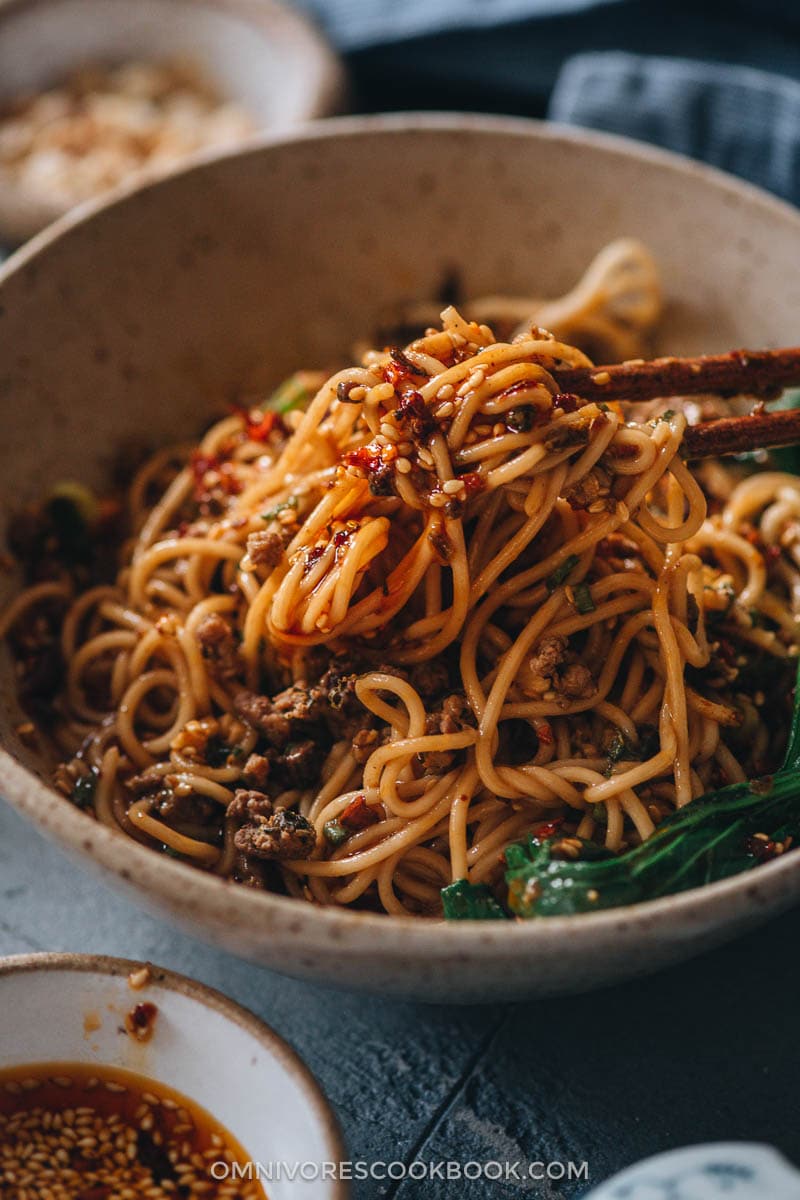
When you go into different restaurants, you’ll find each chef has their own interpretation on dan dan noodles.
In Sichuan restaurants in China, the dan dan noodle dish is more of a snack than a main and is usually served in a small bowl. The noodles are mostly immersed in a thick red broth made with chili oil, with a small amount of pork on top. The dish can sometimes be more soupy and very spicy, but it depends on the chef.
After the dish was introduced in the US, it was transformed and now looks more like a pasta dish — boiled noodles with a meat sauce on top. Sometimes the sauce is more sweet and sour than spicy, almost like a General Tso stir fry (e.g. the Dan dan noodles at Pei Wei). Sometimes the chef will mix Chinese sesame paste into the chili oil to make the sauce creamier and mellow out the spiciness.
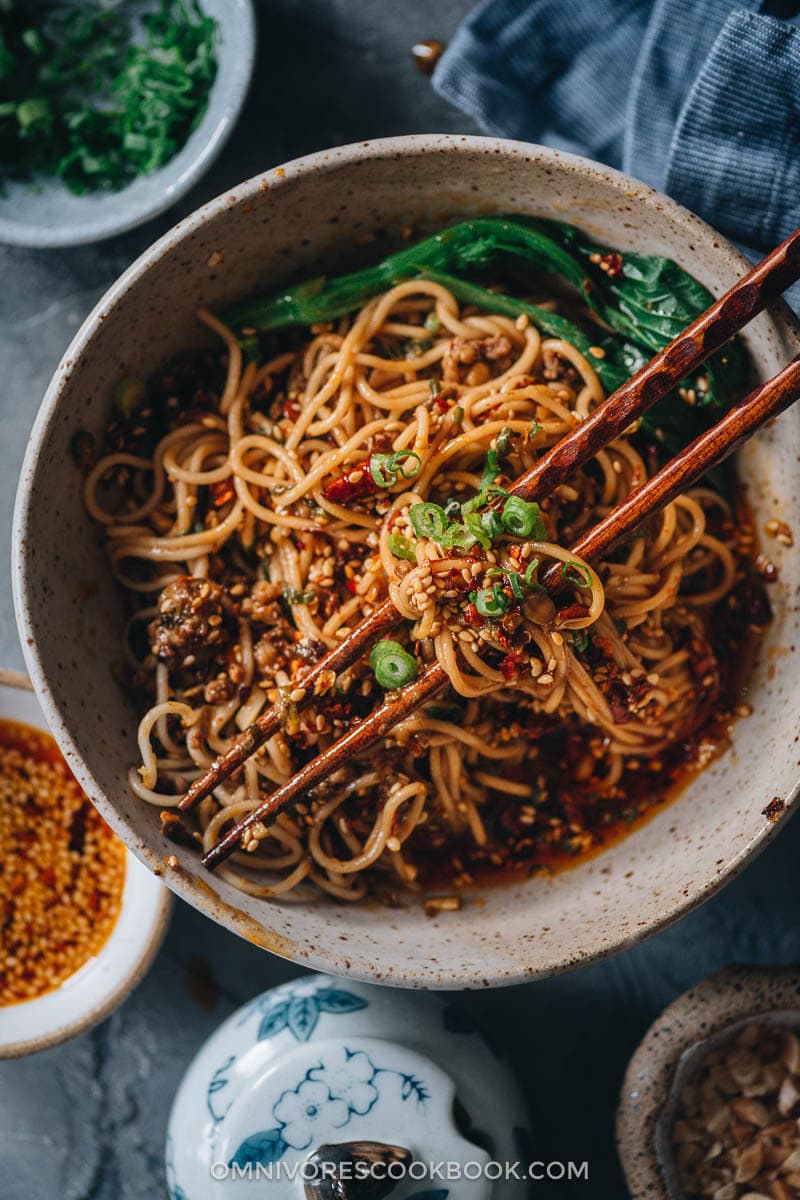
My own interpretation of dan dan noodles
When I make dan dan noodles at home, I use an approach that is 80% true to the original version from Sichuan. You get the ultra-umami, spicy and numbing-ness coming from the fried pork, pickled mustard greens, homemade chili oil, and Sichuan peppercorns. But I also mix in some sesame paste to make the sauce creamier and more appealing to anyone who prefers milder food.
Key ingredients
Sui Mi Ya Cai – or preserved mustard green
Sui Mi Ya Cai (碎米芽菜) is a must-have ingredient if you want to call a dish dan dan noodles in China. It is a type of cardamine bean sprout that is native to Sichuan. It is dried, flavored with sugar and spices, and fermented. The end result is a dark brown pickle that has a crunchy texture and a one-of-a-kind taste — a bit sweet, salty, and savory, with an earthy umami.
It can be tricky to find Sui Mi Ya Cai, since it’s a specialty ingredient, even in China. You can usually find it in the un-refrigerated section of the Asian supermarket with the pickles. If you do not live near an Asian market you can also purchase it on Amazon.
NOTE: It’s totally possible to create a delicious bowl of dan dan noodles without this ingredient.
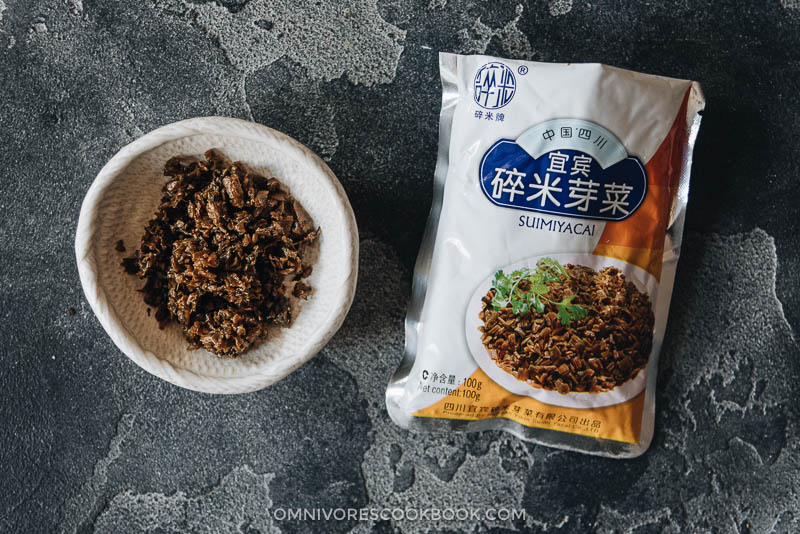
Homemade chili oil
Chili oil is a staple in every family household in Sichuan and the homemade version is a must. It is the main ingredient in dan dan noodles and I highly recommend you make your own. Making chili oil might look daunting at first, but trust me, it only takes 5 minutes. Check out this post to learn how.
NOTE: to anyone who prefers not to eat spicy food — you will still benefit from the homemade chili oil. When you’re making the noodle sauce, you can add a small amount of chili oil to infuse aroma and smokiness; your dish won’t end up very spicy.
Chinese sesame paste
Chinese sesame paste (芝麻酱, zhi ma jiang) is a thick paste made from toasted sesame seeds. Although a lot of original Sichuan dan dan noodle recipes do not contain this ingredient, I prefer to use it to make the sauce creamier. It also balances the spiciness to round out the flavor. It adds great umami too, so your sauce will still taste great if you don’t want to add too much chili oil.
You can find Chinese sesame paste in most Asian grocery stores, or purchase it online. I prefer the sesame paste made with 100% sesame seeds, which has a better taste. You can also find cheaper sesame pastes made from a blend of sesame and peanuts.
NOTE: Chinese sesame paste tastes VERY different from tahini. Do not use tahini as an alternative. If you don’t want to purchase Chinese sesame paste, you can also use natural peanut butter with a few teaspoons of sesame oil mixed in.
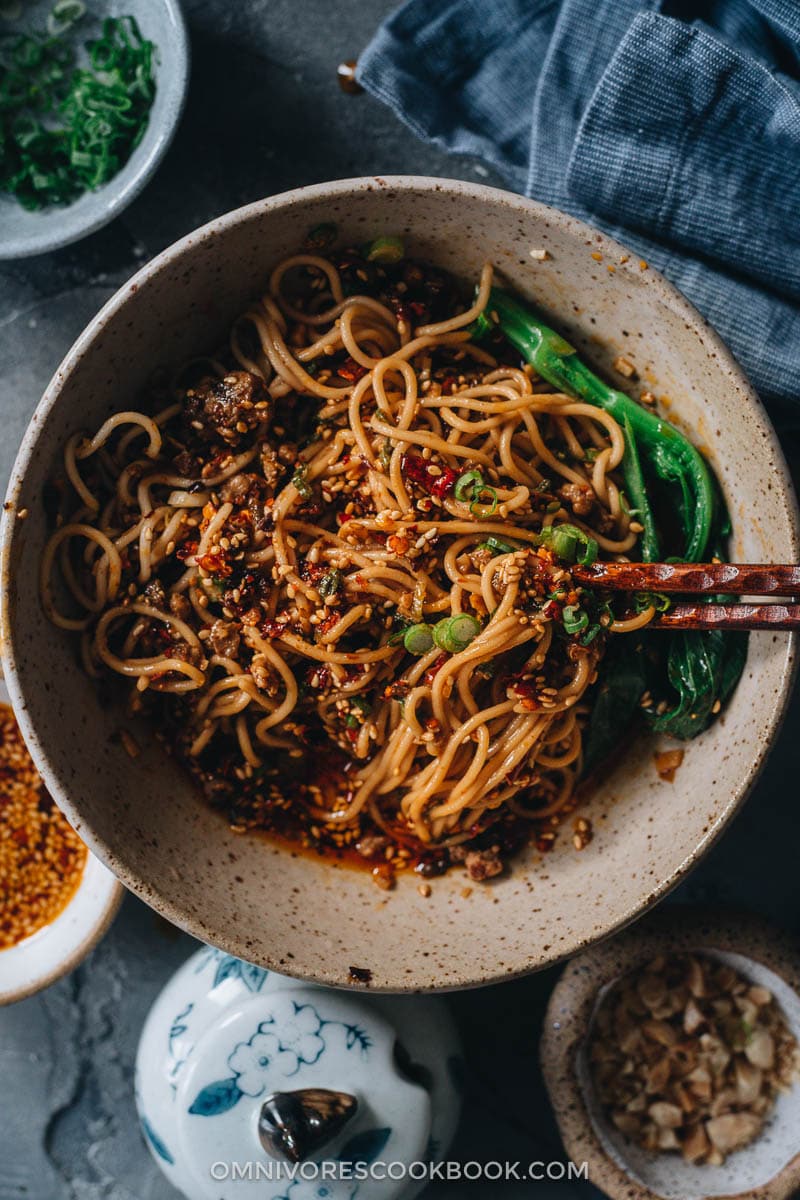
Cooking notes
What type of noodles to use
Dan dan noodles usually use the thin type of wheat noodles. Although it’s usually just a tad thicker than somen noodles. If you’re lucky, you might be able to find the semi-fresh Dan Dan noodles in the refrigerated section in an Asian market. Or you can use any type of dried noodle that is made with wheat and on the thin side.

How to mix the sauce properly
If this is your first time cooking with Chinese sesame paste, you will usually find it is separated into oil on top and thick paste underneath. To make it easy to use, stir the sesame paste thoroughly in the jar to incorporate the oil with the paste. Without this step, you will find the sesame paste very thin on the top of your jar and very dry on the bottom.
Sesame paste has a tendency to thicken when you stir in the liquid. The best way to mix the sauce is to add the sesame paste first, then mix in the liquid ingredients little by little. Whisk the mixture with a pair of chopsticks (or a spoon) until the solid paste is fully blended with the liquid. Then add more liquid and repeat, so everything will dissolve evenly.
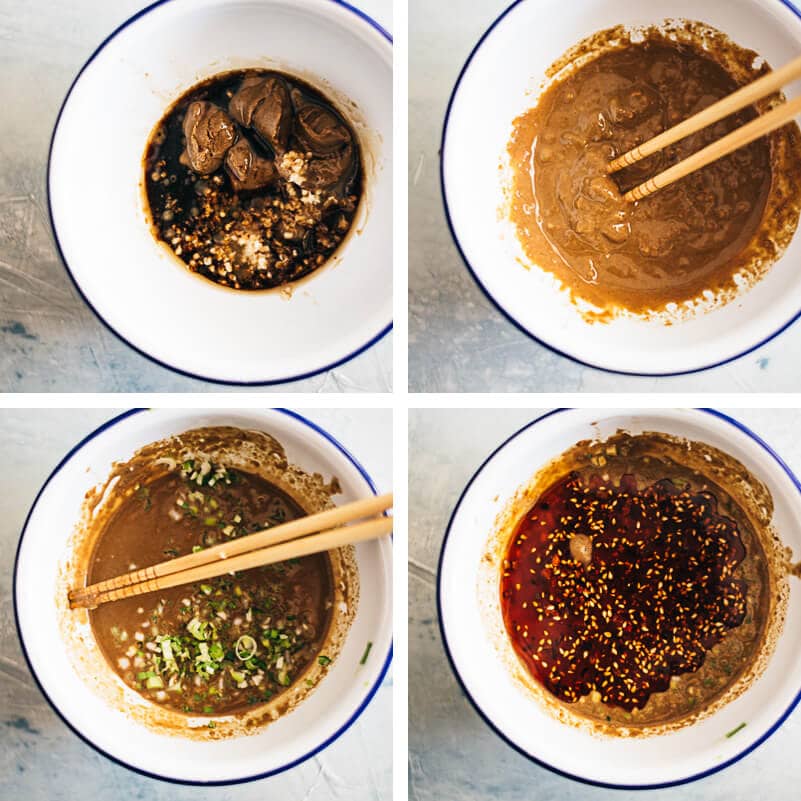
How to fry the pork properly
To properly prepare the pork for dan dan Noodles, you’ll need to “overcook” the pork.
Use medium-high heat to cook brown surface first, then turn to medium heat to let it roast until the liquid in the meat is fully released and evaporated.
In the end you will have dark-brown colored pork without adding any soy sauce. The pork bits will be a bit chewy and have an almost-crispy texture when hot.
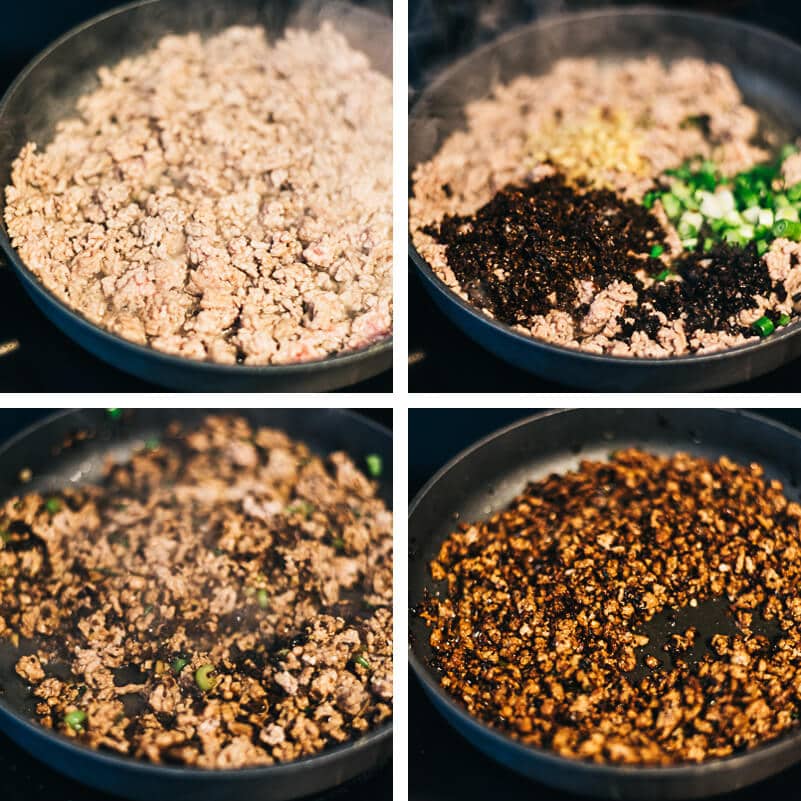
The best workflow
The ingredient list for dan dan noodles might look overwhelming,. The best approach is to get organized and cook one component at a time.
The best workflow is:
- Chop and prep all the vegetables and aromatics
- Mix the sauce (and make chili oil if needed) – this can be prepared ahead
- Cook the pork – Can be prepared ahead
- Boil the noodles
- Use the noodle-boiling water to quickly blanch the vegetables
- Serve everything family-style, so everyone can assemble their noodles the way they like
If you’re preparing this dish for a party, I highly recommend you prepare the sauce and the pork ahead of time. They will stay good in the fridge for a couple of days. Simply boil the noodles and heat up the pork in the microwave right before serving.
To assemble dan dan noodles like a local
To assemble dan dan noodles like a Chinese street vendor:
- Pour some sauce in a small bowl and chili oil according to your taste
- Add the noodles
- Top with minced pork, green veggies, crushed peanuts, and green onions
- Mix and enjoy!
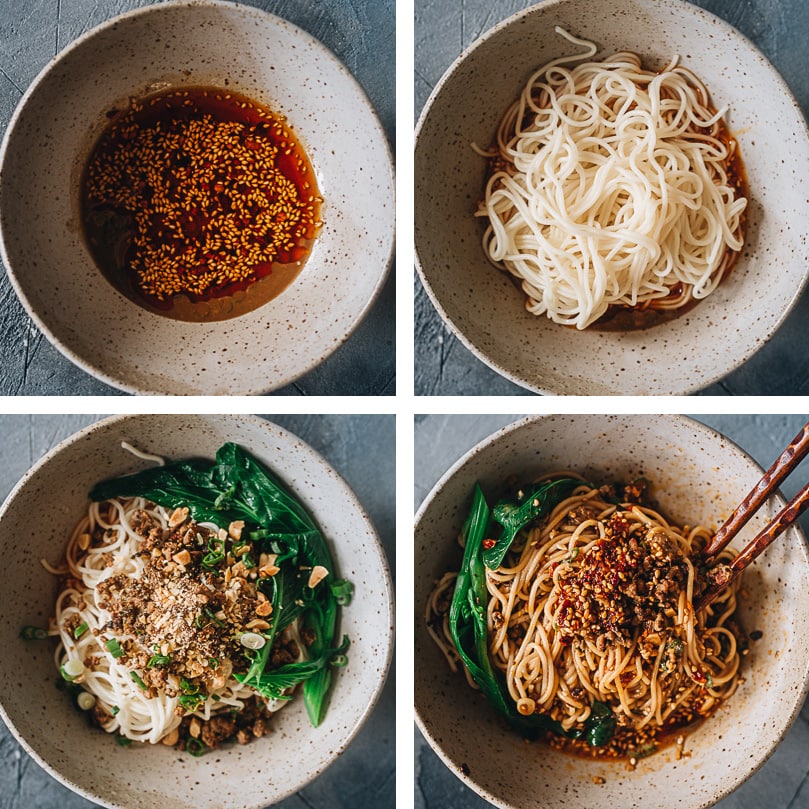
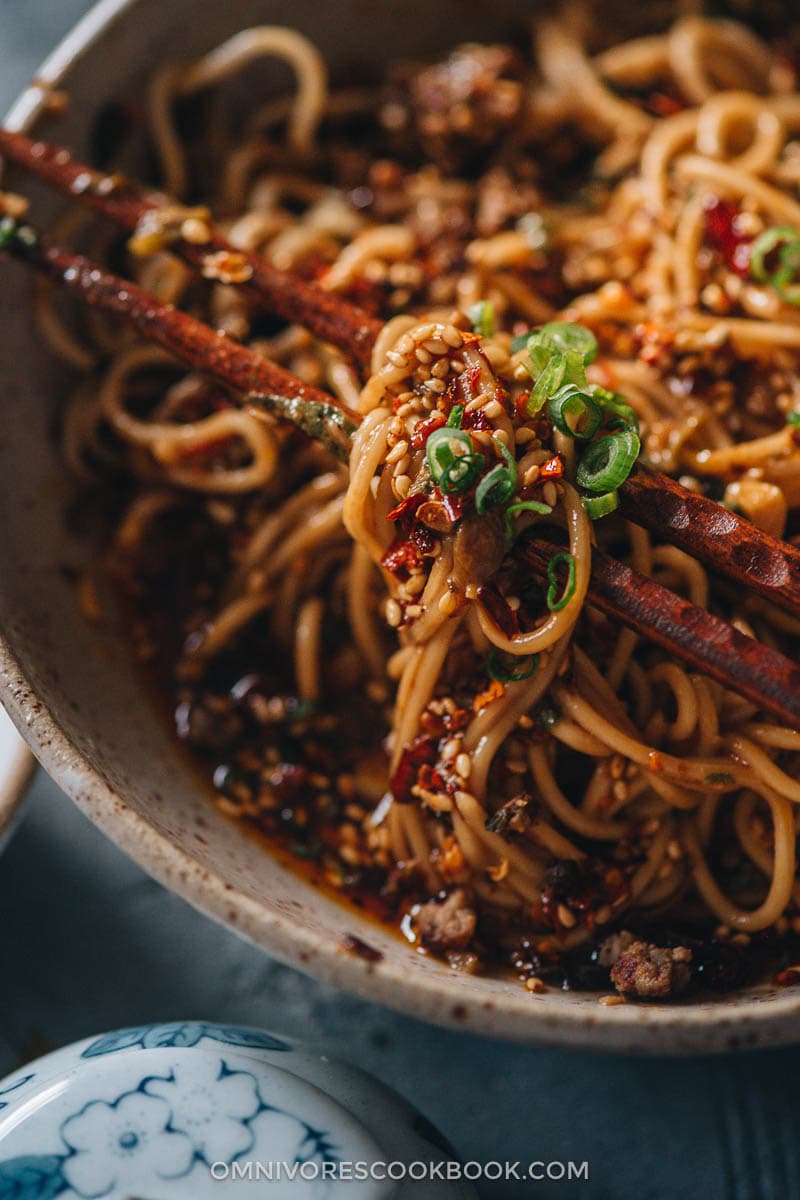
More Sichuan food recipes
- Mapo Tofu
- Sichuan Eggplant Stir Fry
- Dry Fried Green Beans
- Sichuan Mala Chicken
- Sichuan Spicy Wonton in Red Oil
If you give this recipe a try, let us know! Leave a comment, rate it (once you’ve tried it), take a picture and tag it @omnivorescookbook on Instagram! I’d love to see what you come up with.
Chinese Cooking Made Easy
Are you new to this website? This free email series is a great place to start. I’ll walk you through a few of my most popular recipes and show you how and why they work. You’ll quickly start to cook better Chinese food in your own kitchen.
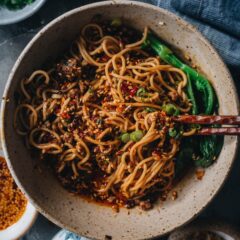
Dan Dan Noodles (担担面)
Ingredients
Noodle sauce
- 1/3 cup Chinese sesame paste (or unsweetened natural peanut butter)
- 1/3 cup light soy sauce (or soy sauce)
- 1/4 cup Chinkiang vinegar
- 4 cloves garlic , finely minced
- 2 green onion , finely minced
- 2 tablespoons honey (or agave syrup)
- 1/2 to 1 teaspoon Sichuan peppercorns , toasted and grounded (*footnote 2)
Pork topping
- 1 tablespoon peanut oil (or vegetable oil)
- 1 lb ground pork
- 1 tablespoon minced ginger
- 2 green onions , chopped
- 1 1/2 tablespoons fermented black beans , rinsed and chopped
- 1/2 cup Sui Mi Ya Cai (Sichuan preserved mustard greens)
- 2 tablespoons Shaoxing wine (or dry sherry)
- 1/2 teaspoon sugar
To assemble
- 1/3 cup roasted peanuts , crushed
- 14 oz Dan Dan noodles (or thin wheat noodles)
- 1 small batch leafy green vegetables , roughly chopped (spinach, choy sum, baby bok choy etc.)
- Homemade chili oil , to taste (*footnote 1)
Instructions
Prepare sauce
- Whisk the sesame paste and light soy sauce together in a bowl until fully incorporated. Add the Chinkiang vinegar. Continue stirring until mixed. Then mix in the garlic, green onion, honey, and Sichuan peppercorns.
Prepare the pork topping
- Heat the oil in a large nonstick skillet over medium-high heat until hot. Add the pork. Cook and stir until the surface is lightly browned.
- Turn to medium heat. Add the ginger, green onion, fermented black beans, Sui Mi Ya Cai, cooking wine, and sugar. Cook and chop the pork into small pieces, until all the liquid has evaporated and the pork turns a dark brown color. Transfer to a bowl and set aside.
Prepare the noodles
- Cook the noodles according to instructions.
- Briefly blanch the leafy green vegetables, drain, and set aside.
To assemble the noodle bowls
- For each noodle bowl, add 1/4 cup of noodle sauce. Add the chili oil according to your taste. Add some noodles, then top with a few spoonfuls of the cooked pork and green veggies. Garnish with peanut crumbles and chopped green onion. Sprinkle with a pinch of toasted ground Sichuan peppercorn, if you like the numbing taste.
- Serve hot or cold.
Notes
Nutrition

Did you make this recipe?
I’d love to hear how it turned out for you! Please take a moment to leave a 5-star rating ⭐️ and share your thoughts in the comments further down the page. It really helps others discover the recipe too.
The recipe was originally published by Feb. 26, 2015 and updated on Apr. 27, 2017.

Steve
This recipe is dope. I make this a few times a year (last night for example), and my family loves it. I fiddle with most recipes, but follow this one exactly as written. Maggie, I LOVE your recipes!
Mags
What’s the weight equivalent of your ½ cup preserved mustard greens? Huge variation depending on how I chop and pack them into the measuring cup…
Maggie Zhu
Sorry I don’t have the gram measurement right now, but the ones I use are finely minced type that comes in the package. If you finely mince it, you should loosely pack it in the 1/2 cup. If you’re not sure, start with less and you can always add a bit more if the pork doesn’t taste salty enough.
Kacey
I forgot to say – I did not have fermented black beans, so I added a tiny bit of Pixian doubanjiang. I also did not have proper dan dan noodles, so I used some other wheat noodles in my pantry that were a similar size and shape. I also used a vegan burger substitute (I think it was Beyond Meat) because that’s what I had in the freezer. Was still delicious! Thank you so much for the care you put into these recipes, I am a big fan of your blog. 🙂
Kacey
I have made this delicious bowl of noodles 3 times now, and I expect I’ll make it a couple more times this week. It’s SOO good! Great job Maggie. The noodle sauce is packed with flavor and tastes amazing with the homemade chili oil. I had leftover chili oil from your Biang Biang noodle recipe, so I used that for the chili oil in the recipe. So good! I did not have Chinese sesame paste (though I ordered some from Mala Market), so I used peanut butter. Cannot wait to try it with the sesame soon!
C Meyer
I made this tonight for dinner and it was delicious!! I didn’t have any sesame paste so I used black sesame paste which tasted just as good. Thanks for the easy to follow recipe!!
Pey-Lih
The sauce is too salty. The preserved mustard greens are salty enough. I think I will omit the thin soy sauce.
Christopher C Maurer
Did you wash the mustard greens as per the package instructions? My package told me to wash it 3 times. I only did twice and the result seemed nicely balanced.
Naomi S
Thank you so much for sharing this delicious recipe Maggie. It was my first try at Sichuan cuisine and it turned out delicious with all your tips/instructions. Looking forward to try all the other recipes. I’m so grateful that I found your website.
Naomi S
Could I substitute the pork for ground chicken?
Maggie Zhu
Yes you totally can!
Bill Kresge
Have you heard from anyone who has made this recipe using zoodles (zucchini noodles)? We’ve made some other Asian dishes replacing egg and wheat noodles with zoodles and been happy with the results.
Maggie Zhu
I haven’t but I think it will work out well since the sauce is very rich and goes great with vegetables.
Bill Kresge
We are ordering the special ingredients you describe in your write up before beginning this culinary experiment. Will be reporting back with our review.
Justin A
My friends and I absolutely loved this recipe.
Andy W
Great recipe! I substitued spinach for the mustard greens and bacon for the ground pork, it was still heavenly, and gets hotter as you get to the bottom of the bowl!
Mike Walsh
Making this tonight using smooth peant butter with added sesame oil
Dillon R
Delicious! I made this last night and I can’t believe how well it turned out. I didn’t have fermented black beans, so I used Pixian bean paste, but only a little under a tbsp, since it’s so salty and had some chili oil incorporated. I also used plain old spaghetti noodles, but they did the trick. I would recommend even more ground toasted sichuan peppercorn as well, since I didn’t get any numbing sensation from the recommended amount (though I may be desensitized to it at this point).
Alex
I loved this recipe ! I switched the meat for dried shitake and it was delicious 😀
Aimee
Drool! I have been making versions of Dan Dan Noodles for yrs! It is just so super delicious in my tummy! I love the ways you combine the ingredients & it tastes so good like your making this dish is your super power!!! THANKS!!!
Divya
Lovely lovely recipe. Super easy to follow and a total keeper
Chef Mimi
Wow. This is fabulous! Could tahini be used instead of the Chinese sesame paste, or is it truly different cause the seeds are roasted first? I have all of the other ingredients except for the mustard greens. I made chili oil a while back and am almost out! Used it for a Chinese hot pot a couple times recently. Such a great thing to have around.
Susan
Absolutely mind blowing! Your entire site should be winning awards. Your recipes are wonderful beyond words. I can’t wait to go to my favorite Asian grocer and get all the ingredients to make some of your recipes that I haven’t tried yet. Enjoy your videos too.
Dee
This recipe is very “rich” in flavor. I LOVE it and have made it a few times already! The recommendation of using peanut butter in place of the sesame paste was much appreciated – not many markets near me and it was sold out online. I used my own homemade noodles the last time I made this and everyone was very impressed. The Mala Market Sichuan peppercorns also make a HUGE difference in getting that amazing “mala” flavor.
Suzanne
We have tried a few Dan Dan noodle recipes and yours has proven to be the closest to the Dan Dan at our favourite hand made noodle shop ( too far to get delivery during Covid). We follow the technique and ingredients as described. We subbed a combination of unsalted peanut butter and sesame oil for the Chinese sesame paste as you had suggested, reduced the ground pork mixture by 1/2 to suit our taste, and use locally made fresh noodles we keep in our freezer. It is indulgent but healthier than most take out. One of the few dishes for which I can convince my husband to put down the take-out menus on a Friday night. Thank you!
Maggie
Thanks for leaving a thorough review and I’m glad to hear that you and your husband both enjoyed the dish! All the modifications sound good to me! The original dish uses very little pork, but I increased the amount to make it a more prominent meal. I thinking cutting it to half makes it more authentic 🙂 Happy cooking and can’t wait to hear what you’ll cook the next!